

DMT Dimethyltryptamine. Monoamine oxidase inhibitor. Monoamine oxidase inhibitors (MAOIs) are chemicals which inhibit the activity of the monoamine oxidase enzyme family.
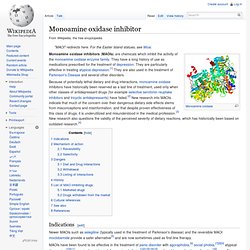
They have a long history of use as medications prescribed for the treatment of depression. They are particularly effective in treating atypical depression.[1] They are also used in the treatment of Parkinson's Disease and several other disorders. Indications[edit] Newer MAOIs such as selegiline (typically used in the treatment of Parkinson's disease) and the reversible MAOI moclobemide provide a safer alternative[5] and are now sometimes used as first-line therapy. MAOIs can also be used in the treatment of Parkinson's disease by targeting MAO-B in particular (therefore affecting dopaminergic neurons), as well as providing an alternative for migraine prophylaxis. Dimethyltryptamine. History[edit] Another historical milestone is the discovery of DMT in plants frequently used by Amazonian natives as additive to the vine Banisteriopsis caapi to make ayahuasca decoctions.

Biosynthesis[edit] Biosynthetic pathway for N,N-dimethyltryptamine This transmethylation mechanism has been repeatedly and consistently proven by radiolabeling of SAM methyl group with carbon-14 (14C-CH3)SAM).[22][20][24][25][26] Safety of Peyote when Used Religiously' A Note on the Safety of Peyote when Used Religiously. by Matthew J.

Baggot Note: this essay was originally posted to the alt.drugs newsgroup as part of an informal discussion on past mescaline research. Although it has been reorganized and expanded by the author for its inclusion in the Council on Spiritual Practices web site (www.csp.org), it is still meant as an informal note rather than an exhaustive literature survey. Among the psychedelic drugs, mescaline is perhaps the best understood. Peyote's long tradition of use has been used to examine whether it might be mutagenic. A more interesting type of study investigates the psychological safety of religious peyote use. However, they saw "almost no acute or chronic emotional disturbance arising from peyote use (p. 697). " This low number of cases allowed Bergman to make some estimates about the actual incidence of adverse reactions to peyote: ...The Native American Church of Navajoland estimates its membership at 40,000.
Matthew J. Proper peyote harvesting technique - a cacti growing blog. Lophophora williamsii (peyote) populations have diminished in large areas of South Texas where peyoteros harvest the cactus for ceremonial use by the Native American Church.
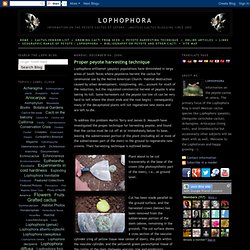
Habitat destruction caused by urban development, rootplowing, etc., account for much of the reduction, but the regulated commercial harvest of peyote is also taking its toll. Some harvesters cut the peyote too low (it can be very hard to tell where the shoot ends and the root begin) - consequently many of the decapitated plants will not regenerate new stems and are left to die. To address this problem Martin Terry and James D. Peyote. Lophophora williamsii /loʊˈfɒfərə wɪlˈjæmsiaɪ/ is a small, spineless cactus with psychoactive alkaloids, particularly mescaline.[2] The Spanish common name, also used in English, is peyote[3] (/pəˈjoʊti/; from the Nahuatl word peyōtl [ˈpejoːt͡ɬ]), which means "glisten" or "glistening".[4] [5] Native North Americans are likely to have used peyote, often for spiritual purposes for at least 5,500 years.[6] Peyote is native to southwestern Texas and Mexico.
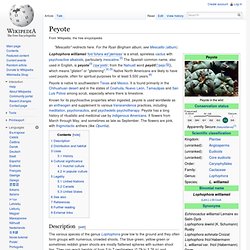
It is found primarily in the Chihuahuan desert and in the states of Coahuila, Nuevo León, Tamaulipas and San Luis Potosi among scrub, especially where there is limestone. Description[edit] Lophophora williamsii with small, red fruit The various species of the genus Lophophora grow low to the ground and they often form groups with numerous, crowded shoots. Lophophora williamsii seedling at roughly 1 1/2 months of age. Tensegrity (Castaneda) For other uses, see Tensegrity.
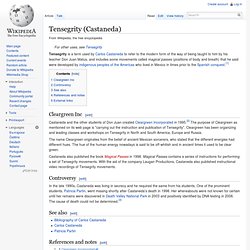
Nagual. The Naguals, shapeshifting creatures.
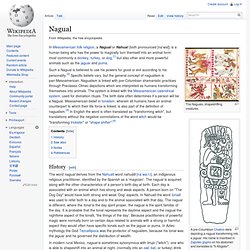
A pre-Columbian Chatino stela depicting a nagual transforming into a jaguar. His name is inscribed in Zapotec glyphs on his abdomen and translates to "5 Alligator". Datura stramonium. Datura stramonium, known by the common names Jimson weed, Devil's snare or datura, is a plant in the Solanaceae (nightshade) family.
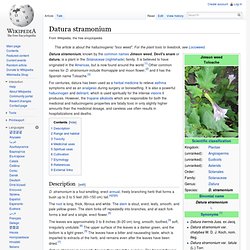
It is believed to have originated in the Americas, but is now found around the world.[1] Other common names for D. stramonium include thornapple and moon flower,[2] and it has the Spanish name Toloache.[3] Description[edit] D. stramonium is a foul-smelling, erect annual, freely branching herb that forms a bush up to 2 to 5 feet (60–150 cm) tall.[4][5][6] The root is long, thick, fibrous and white. The stem is stout, erect, leafy, smooth, and pale yellow-green. The leaves are approximately 3 to 8 inches (8–20 cm) long, smooth, toothed,[5] soft, irregularly undulate.[6] The upper surface of the leaves is a darker green, and the bottom is a light green.[5] The leaves have a bitter and nauseating taste, which is imparted to extracts of the herb, and remains even after the leaves have been dried.[7] Fruits and seeds - MHNT.